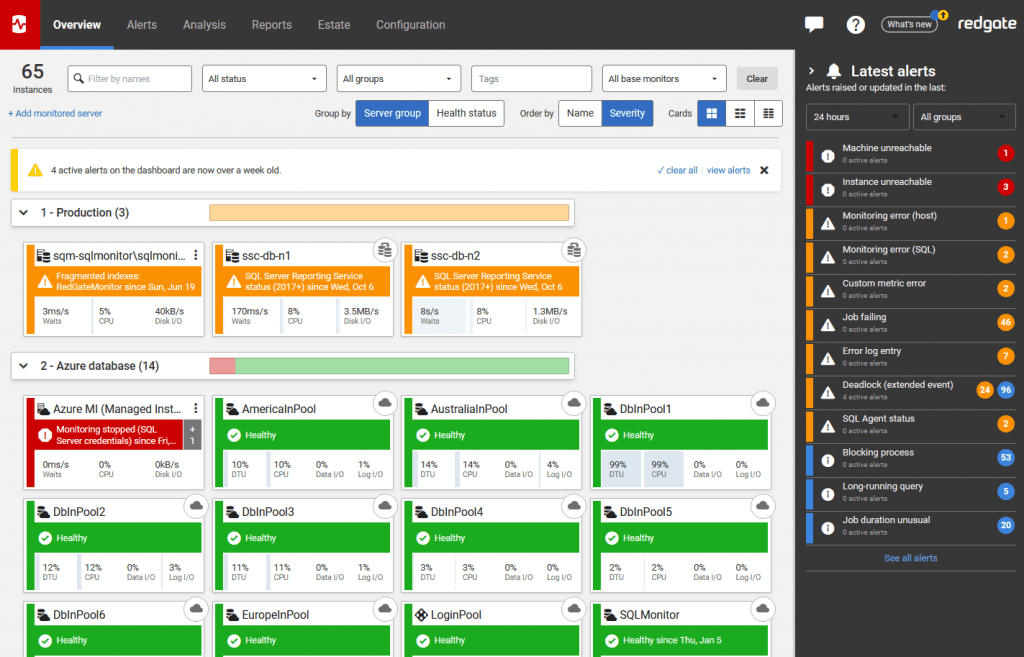5 things to look for in a database monitoring tool

Databases are the backbone of enterprise-level organizations, facilitating efficient data management, supporting critical business processes, and providing a foundation for secure innovation and growth. Effective database monitoring is critical for maintaining a high level of performance, security, and reliability in database systems, particularly in enterprise-level environments where large volumes of data and critical business operations are involved.
Whether you’re moving from an existing database monitoring solution for better results or implementing one for the first time, choosing the best database monitoring tool for your needs can be a crucial task – your chosen monitoring solution can make all the difference to your organization’s performance and mitigate risk.
As more and more organizations grapple with rapidly evolving server estates, diverse hosting environments, and increasing data complexities, the need for a comprehensive database monitoring tool becomes vital. In this article we explore five essential points that set the best database monitoring solutions apart – highlighting crucial factors such as scalability, intuitive use, proactive performance monitoring, team collaboration and continuous development. Read on to learn more.
1. Scales with your server estate size and needs
The growth of data generation and its storage is well documented. IDC’s Global DataSphere forecast for 2021-2025 predicted that global data creation and replication will experience a compound annual growth rate (CAGR) of 23% over the forecast period. Digital transformation initiatives including AI and ML are all made possible and benefit from this data. With this growth comes the need to scale and manage database estates too.
The best database monitoring tool will allow for effective management from a single screen or dashboard, across different platforms or database types, providing that ‘at-a-glance’ overview to ensure uptime. Effective monitoring and performance tuning itself is fundamental to informing database scaling strategies by easily understanding where issues with bottlenecks, latency or resource utilization have occurred. Furthermore, a competitive price with predictable costs is important to consider at the outset of any product evaluation. It may seem obvious but add-ons, usage-based charges and varying editions are all aspects to consider in parallel with your needs today, whilst permitting ultimate flexibility for the future.
Server set ups, hybrid estates, complexity, the volume of data and how your data is hosted can all change, so the best database monitoring solutions operate across multiple database platforms and scale with your estate size and needs regardless of the number of databases, or where your servers are hosted (e.g. Virtual Machines, Azure SQL Databases, Google Cloud or Amazon RDS or EC2). Read more about Cloud Database Monitoring with Redgate Monitor here. Furthermore, a consistent user experience, regardless of platform monitored, has significant benefits, which leads to point two.
2. Database Monitoring for the entire team
The best database monitoring tool is one that is going to fulfil the needs of the entire team and offers a consistent user experience cross-platform.
Consistent, easy-to-use and intuitive web-based user interfaces, quickly digestible and actionable insights and options to configure alerts are vital to accelerating problem-solving in hybrid environments, help avoid information overload and significantly reduce user fatigue. Where one person may be responsible for monitoring several platforms, this means no additional training or thinking, with one tool consistently monitoring all of them at once. Regardless of individual experience level, users need to be able to get up and running quickly, minimizing the time to value. Even the most experienced DBA should benefit in the heat of the moment with options to deep dive to the level of detail required. Whilst most vendors will claim a ‘friendly’ UX by default, adopting new technologies offers an opportunity to delve into what it means to be ‘easy-to-use’ and so embrace and enable diverse experience levels and team requirements. Additional features like customizable alerts and color coding can help focus immediate attention and prioritization, whilst in-tool recommended actions can significantly accelerate the time to resolution.
3. Helps move beyond firefighting
Moving to a proactive, rather than reactive, state of database monitoring will save you time, improve retention rates, reduce stress levels and improve operational performance. The best database monitoring tools allow you to spot potential problems before they impact your users, ensuring business continuity and customer satisfaction. In turn this gives valuable time back to plan the best course of action and further improve performance and security. The very best database performance monitoring tools will help you stay on top of things like disk space usage, backups, agent jobs, and the application of recent updates and patches with a simple overview. Furthermore, they’ll predict future requirements based on trends so you can proactively address issues before they escalate into costly downtime, performance or security issues.
4. Enables collaboration between DBAs and developers
Database monitoring is an essential part of database development, so delaying it to production means you’re missing out on discovering problems early. Working with developers so that they can rewrite slow-running queries or redesign inefficient processes means catching weak points early and avoids introducing problems into production. With granular access controls granting access to just the servers they need, this enables collaboration between developers and database administrators which saves time, improves operations and, ultimately, means the database becomes even more stable and secure whilst achieving faster, more streamlined, deployments. Providing developers with access to this diagnostic data for the servers they work with helps to better understand the impact of code changes, whilst also providing opportunities to collaborate on improving query design. Working together in this way will help avoid problems like slow-running queries before deploying changes to production and opens further collaboration between development and operations.
5. Continuous vendor commitment and database domain expertise
The best database monitoring tool will, arguably, be the one of tomorrow. As such, the vendor pedigree, support and continued development with any solution is important to consider as part of any evaluation. Continuous investment and improvement from dedicated, in-house development teams demonstrates a vendor commitment to the security and performance of any solution and guarantees it is future proof. The augmented product is also worth looking at here; consideration is often given to the types of support available in the form of training and support materials, access to experts, specific database industry experience, customer base and the community.
Summary
As organizations navigate evolving and expanding server estates and increasing data complexities, scalability, intuitive use, proactive performance monitoring and enhanced team collaboration can set the best database monitoring solutions apart. By choosing a solution that aligns with these principles and is backed by continuous development and support from industry experts, organizations can not only meet their current needs but also position themselves for sustained success for the future.
If you’d like to find out more about Redgate’s database monitoring tool, Redgate Monitor, watch the short introduction video, try the online demo or download a free fully-functional trial here.
On-demand demo
See Redgate Monitor in action
Whether your databases are hosted on premises, in the cloud or a mixture of both, you need to be sure you can always have the answers to the health of your estate. Discover how Redgate Monitor enables this in this short demo.
